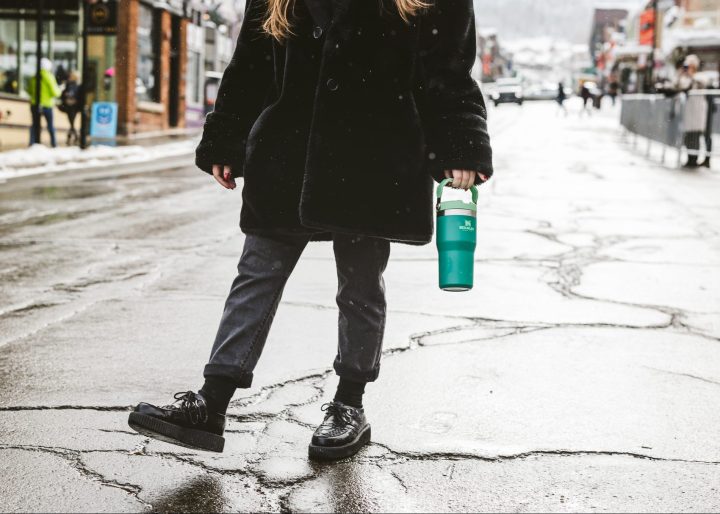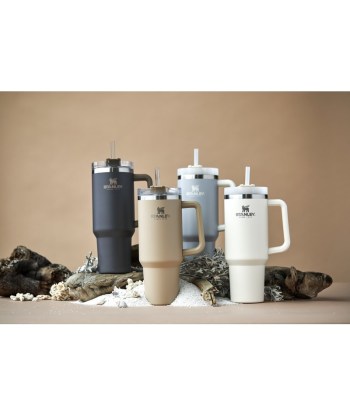
How does a water bottle go viral — and stay viral?
Share Now on:
How does a water bottle go viral — and stay viral?

For Christmas, Sarah Anderson decided to buy herself one of the most coveted pieces of drinkware on the market: The 40-ounce Stanley Quencher H2.0 FlowState Tumbler.
Anderson first saw it on Instagram, when several members of the Dallas Cowboys Cheerleaders posted the tumbler in their stories. Then, it kept showing up on her feed.
“I think I was definitely influenced by the internet,” Anderson said.
Tumblers, water bottles, beverage containers or whatever else people want to call them have become even more popular over the last several years. Brands like Yeti and Hydro Flask have gone through several trend cycles in the reusable drinkware market, which was worth more than $28 billion in 2022. What makes people go wild for highly specific drink receptacles?
“A lot of us are into wellness, staying hydrated, drinking your vitamins, this and that,” said Melina Vega, a lifestyle, beauty and fashion content creator. She explained that people will be willing to pay a little more for a water bottle if it has a handle, fits in a cup holder, comes in multiple colors and complements their overall aesthetic. Plus, she said the “girlies,” or influencers on TikTok, make these products popular by simply talking about them.
Emily Moran, a content creator with over 235,000 followers on TikTok, said she remembers when people were obsessing over all things Yeti a few years ago, and she knows many people who collect Starbucks cups.
“People like to belong to something, or they just like to follow the trends,” she said.
Moran recently bought a 30 oz. Stanley Flip Straw Tumbler to replace her beloved Hydro Flask. In a recent TikTok post where she showed herself unboxing her Stanley, she explained that she likes her water bottles to have built-in straws. The post garnered nearly 322,000 views and 44,000 likes.
“If I hit at least 10,000 views on a video, I’m like, ‘OK, cool,’” Moran said. “Of course, when you add the tag of ‘Stanley cups’ … it’ll probably get bigger than normal videos.”
Short-form social media has accelerated the trend cycle of various products, according to Justin Huang, an assistant professor of marketing at the University of Michigan. The popularity that used to be created via TV and movies is now being generated on social media, and brands are looking online for cues on how people express themselves through products.
“We’re seeing a lot more accessories become fashion items and status symbols,” Huang said. “Now, the water bottle and a kind of athleisure is ascendant, and we need the matching product to boot.”
Stanley tumblers, thermoses and water bottles have become a viral sensation on Instagram and TikTok, with over 148 million views for searches like #stanleytumbler. Countless content creators have been sharing “unboxing” videos and product reviews, garnering hundreds of thousands of likes.
Sure enough, these likes have translated into significant sales gains, doubling the company’s business two years in a row, according to Stanley Global President Terence Reilly. In particular, Reilly said, there was a 275% increase in Quencher H2.0 FlowState Tumbler sales last year, and the waitlist for the product has reached an all-time high, with an estimated 150,000 consumers registered on the direct-to-consumer website.
The mechanics of a quiet brand makeover
Cheerleaders and social media influencers didn’t always come to mind when thinking of Stanley. For over 100 years, Stanley has mostly marketed itself as a rugged camping and outdoors brand.
“Green, male and hot. That’s what Stanley has been, and we’re proud of that,” Reilly said. He described Stanley as an American legacy brand and pointed to the green Stanley thermos as the top choice for construction workers, teachers, nurses and others. The brand also has a reputation for being sustainable, Reilly noted. Recently, Stanley appeared at the Sundance Film Festival in Utah as the event’s official sustainability and drinkware partner.
“I shared our IMDB page because that green bottle has been in so many TV shows and films that it’s been part of the American scene for a long time,” Reilly said. He explained that the brand also wants to associate itself with “creators, builders and inventors,” and by working with events like Sundance, it’s able to maintain that image.
But the idea of adjusting the audience it markets to originated with the three women behind the popular e-commerce blog The Buy Guide, who began linking the Quencher on their website in 2017 after falling in love with the product themselves. It sold out quickly each time they shared it. Once Stanley stopped restocking the product at the end of 2019, the women of The Buy Guide wondered whether they could introduce the company to a different demographic: women.
“It’s not just a product, it’s a lifestyle,” said Taylor Cannon, one of the three co-owners of The Buy Guide. She explained that they pushed this onto Stanley when national sales manager Lauren Solomon reached out to them after seeing a post from former “Bachelor” winner Emily Maynard Johnson, who showcased her own cup that The Buy Guide gifted her. Solomon agreed to provide more Quenchers to the site. With each launch, they sold out.
“I think it speaks to the power of women selling to women,” Cannon said.
Cannon and her co-owners then met with the Stanley leadership team to discuss their vision for revamping their website and refocusing on how the product could be used for everyday things like carpooling and grocery shopping and also incorporate different color and design options. In 2019, they officially became a part of Stanley’s affiliate network.
“We wanted to stay green, male and hot but also become more colorful, female and cold,” Reilly said. He explained that while Stanley planned to still advertise to the outdoorsman, it would also stylishly focus on this missed audience of women on the go, who need their cold drinks to last all day.
With every launch of the Quencher on Stanley’s website, Reilly said, it has sold out rapidly, and the company has since added partners like REI and Dick’s Sporting Goods. While this does speak to the power of women selling to women, it also speaks to the power of social media in rebranding efforts, experts say.
“These social media platforms are quicker to pick up on trends, quicker to deliver them to consumers that might be interested in the same topics,” said marketing professor Huang.
Reilly said the company understands the value of working with influencers, tastemakers and content creators who can act as megaphones for the brand and show their audiences why they love Stanley.
“Speed is really important,” Reilly said. “The consumer moves very fast, and you have to decide and execute quickly … to build and develop that relationship.”
Whether or not Stanley can keep up the hype around its tumbler remains to be seen. Huang said it can be challenging for companies like Stanley to maintain their popularity.
“How do we balance between making sure the product is available to consumers, but also making it exclusive enough that people are interested in it?” Huang said. He explained that brands like Stanley that are trending online can reach a sort of “tipping point,” or a time where the next trending product could knock them off the consumer’s radar.
Reilly isn’t too worried about maintaining Stanley’s momentum, citing the combination of the brand’s heritage, reputation and continued innovation. “We’re doing a brilliant job of merging yesterday with today and I’m sure tomorrow,” Reilly said.
For now, the brand seems to be finding new audiences. Now that she has a Stanley tumbler, Melina Vega said, her 12-year-old daughter wants one too.
“Now, I have a little extension of me … she sees everything that I do,” Vega said. “There’s no way this brand is going to die down right now.”
There’s a lot happening in the world. Through it all, Marketplace is here for you.
You rely on Marketplace to break down the world’s events and tell you how it affects you in a fact-based, approachable way. We rely on your financial support to keep making that possible.
Your donation today powers the independent journalism that you rely on. For just $5/month, you can help sustain Marketplace so we can keep reporting on the things that matter to you.


















